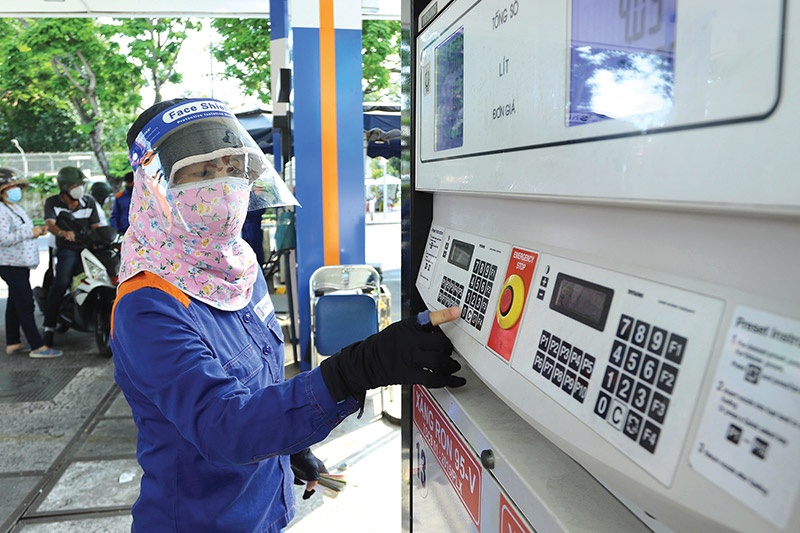Vietnam riding the wave of inflationary unpredictability
 |
| Petrol retail prices in the country have been adjusted many times over the past few months, Photo: Le Toan |
In Vietnam, gasoline prices continue to increase, and after the adjustment on May 11 by the Ministry of Industry and Trade (MoIT) and the Ministry of Finance, each litre of E5 RON92 petrol increased by 6.5 US cents to $1.26 per litre while RON95 climbed by 6.7 US cents to $1.30 per litre.
On May 17, the price of US WTI crude oil remained at a high level of over $114 per barrel while Brent oil maintained its upward momentum at $114.28 per barrel.
Before the next adjustment, which was due on May 21, petrol prices in Vietnam were forecast to continue to increase to higher levels. The ministries first adjusted gasoline prices on January 11 due to a decrease in global supply, production output by Kazakhstan and Libya, and oil inventories of the United States.
According to Decree No.95/2021/ND-CP, effective from January, there will be three adjustments each month to the retail price of petrol and oil.
Petrol prices in Vietnam increasingly depend on global ones as domestic supply does not meet demand. For instance, the output of the Nghi Son refinery has declined since the beginning of the year due to financial problems.
The MoIT expects gasoline demand in the second quarter of 2022 to climb to about 5.2 million cubic metres, while the supply in the next quarter is expected to reach 6.7 million cu.m.
Following the report of Nghi Son Refining and Petrochemical Co., Ltd., the company is currently trying to refine and output 1,83 million cu.m, of which 590,000cu.m were planned for April, 630,000cu.m are for this month, and 610,000cu.m for next. However, the implementation of this plan depends on multiple factors.
Rising commodity prices are putting pressure on Vietnam’s inflation, a problem that western countries are also facing. Dragon Capital at the end of March proposed two scenarios of how oil prices could affect Vietnam’s inflation in 2022.
In the first scenario, when the average oil price for the whole year would be at $95-130 per barrel, Vietnam’s inflation could fluctuate between 3.7 and 5.3 per cent. In the second scenario, if the average oil price is at $110 per barrel, inflation could be at 4.2 per cent.
Dang Nguyet Minh, head of research at Dragon Capital, found that petrol prices are the factor that has the biggest impact on Vietnam’s inflation. The country is paying nearly $1.30 per litre of RON95, 15 per cent higher than the average state in the US, only lower than California, the state with the highest gasoline prices in the US.
“The increase in gasoline prices was partially reflected in the February consumer price index (CPI) this year. At that time, transportation costs increased by 15 per cent over the same period last year and this cost contributed 10 per cent to the inflation basket, thereby pulling the CPI of Vietnam up to about 1.5 per cent. In return, other cost factors decreased such as healthcare and food, helping the CPI increase by 1.4 per cent over the same period,” said Minh.
Vietnam maintained a balanced monetary policy for the past five years, despite an increase in commodity prices, including many food prices. However, rice and pork prices remained relatively stable. “Those two factors are important and render the current level of inflation risk much lower than in 2011, the year Vietnam’s inflation reached 18.13 per cent, the highest level since 2008,” said Minh.
The Dragon Capital analyst noted another important metric, the core CPI, which excludes fluctuations in food and energy prices. Currently, Vietnam’s core CPI is at 0.68 per cent, and the economy can only accept an increase of about 2 per cent.
Inflation in Vietnam is generally difficult to avoid given the negative impacts from global markets. Research by the National Economics University (NEU), published at the end of April, estimated that by March 11, the domestic gasoline price had increased by 45.2 per cent compared to the end of last year, which directly affected the CPI increase by 0.5-0.6 per cent and is one of the main factors that threatens the 4-per-cent inflation target. The government set that target last October when gasoline prices were not as volatile as they are now.
Assoc. Prof. Dr. To Trung Thanh from the NEU commented, “The pressure on inflation comes from basic commodity prices, plus the military tensions between Russia and Ukraine, causing energy prices to rise to a record high affecting domestic production. Rising global inflation also puts pressure on Vietnam’s inflation.”
Thanh also pointed out that the ratio of money supply or credit to the GDP of Vietnam has increased sharply in the last two years, with a growth rate of around 6.2 per cent. “If GDP stays around this level, there will be a balance within the economy and there will not be much pressure on inflation,” he added.
| - The Asian Development Bank forecasts that Vietnam’s economic growth will recover to 6.5 per cent in 2022 and reach 6.7 per cent in 2023. - The World Bank forecasts that Vietnam’s GDP growth will reach 5.3 per cent in 2022, then stabilise at around 6.5 per cent. - The International Monetary Fund lowered its forecast for global economic growth in 2022 to 3.6 per cent but still forecasts that Vietnam’s GDP will grow at 6 per cent in 2022 and 7.2 per cent in 2023. - The country’s Programme on Socioeconomic Recovery and Development is calculated to contribute about 2.9 per cent to 2022’s GDP growth, and 0.2 per cent in 2023, facilitating the completion of the growth target. |
| Vo Thanh Hung-Deputy Minister of Finance
In Vietnam, the average inflation in the first quarter of 2022 increased by 1.92 compared to the previous year, a moderate increase. Based on the growth rate of the first quarter of 5.03 per cent – which is predicted to be higher in the following quarters – if inflation is controlled, it is expected that state budget revenue this year can reach or exceed the plan. However, to control inflation below 4 per cent, it is necessary to reduce the simultaneous impact of cost-push costs, increase the supply of goods, and disseminate information in a way that avoids the psychological impact of expectations. The socioeconomic development support package has been taken into account if required, and an increase in spending has been approved by the National Assembly. In addition, in 2022, further reduction of environmental protection tax on petrol and oil will be continued, coupled with relaxing some other taxes and fees. All of these solutions will, of course, have an impact on the state budget revenue. It is estimated that the total reduction of taxes, fees, and charges in 2022 amounts to up to $3.9 billion. Phan Duc Hieu-Standing member Economic Committee of the National Assembly
The Programme on Socioeconomic Recovery and Development has a relatively large scale, suitable for the domestic situation and for controlling macro risks. The programme must avoid wasting resources to help restore production and business, and remain public and transparent. The programme has created an opportunity to quickly restore production and supply chains, promoting growth drivers. Thereby, the state strives to achieve an average growth rate of 6.5-7 per cent per year in the next four years. However, with many challenges ahead, the efforts of all parties are needed. Each enterprise also needs to first change itself and adapt to the new context with dynamism, creativity, and better management. There are two scenarios of GDP growth in 2022 and 2023. In the baseline scenario, Vietnam’s GDP will increase by 5.5-6 per cent while in the negative scenario, GDP will only grow by 4.5-5 per cent. The variables in the two scenarios are depending on the level of pandemic prevention, the effectiveness of the Programme on Socioeconomic Recovery and Development, and Vietnam’s ability to mitigate the impact of the Russia-Ukraine conflict. Francois Painchaud-Resident representative for Vietnam and Laos International Monetary Fund
Vietnam’s GDP growth is forecast to reach 6 per cent for 2022 and 7.2 per cent for 2023, and inflation is expected to increase but remain below the target of 4 per cent. However, there are still significant uncertainties to the economic outlook. Externally, an increase in geopolitical tensions could negatively affect economic activity and result in higher inflation. A significant slowdown in growth in China could also make this worse. Vietnam has successfully maintained fiscal stability, external balance, and financial stability. But the country’s economic recovery has been uneven and there are some risks as the growth outlook is slowing and the inflation rate is increasing somewhat. There are also other risks, such as tightening global financial conditions and developments in the domestic real estate market and with corporate bonds. Thus, Vietnam’s fiscal policy in the coming time should take the lead in supporting all actors, especially if the risk of a growth slowdown becomes a reality. |
What the stars mean:
★ Poor ★ ★ Promising ★★★ Good ★★★★ Very good ★★★★★ Exceptional
Related Contents
Latest News
More News
- 14th National Party Congress affirms Party’s leadership role, Vietnam’s right to self-determined development (January 20, 2026 | 09:27)
- Direction ahead for low-carbon development finance in Vietnam (January 14, 2026 | 09:58)
- Vietnam opens arms wide to talent with high-tech nous (December 23, 2025 | 09:00)
- Why global standards matter in digital world (December 18, 2025 | 15:42)
- Opportunities reshaped by disciplined capital aspects (December 08, 2025 | 10:05)
- Fresh M&A cycle ahead as reforms begin to take effect (December 08, 2025 | 08:00)
- What foreign investors need to know to unlock new deals (December 08, 2025 | 08:00)
- Telecoms advances expected to penetrate all sectors and fields (December 03, 2025 | 13:00)
- Main drivers for Vietnam’s digital economy future (December 03, 2025 | 11:35)
- Pivotal stage of growth paves way for rise in M&As (December 03, 2025 | 10:00)




 Tag:
Tag:


















 Mobile Version
Mobile Version